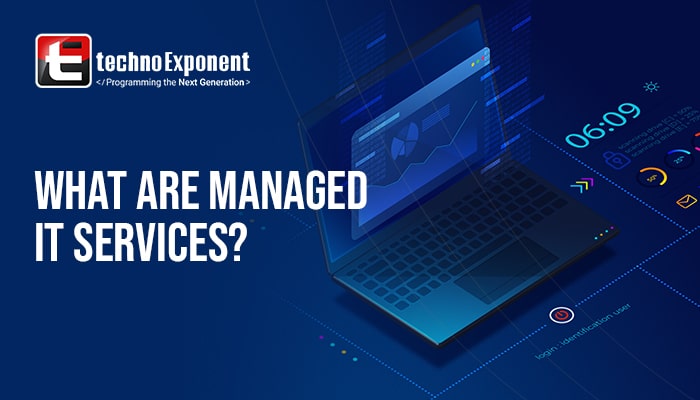
In order to run a business smoothly, every company needs someone to manage IT services. Many moving parts keep small-medium businesses (SMBs) running and their data safe, from computers to phones to networks to passwords. Most SMBs do not have the time, talent, or money to handle IT tasks themselves.
You will need to decide what kind of technical support is needed because IT-managed services can be quite broad. One of the challenges here is that there is no one in all and you have to learn about several services before you get to the right one.
In the managed software development service, as well as all other IT services, you receive a team who has worked together before (and not a collection of independent contractors) and you don’t need to invest in in-house staff members or infrastructure to achieve a fully functional product. Ultimately, this speeds up software development and allows you to focus on other critical tasks.
This blog will help you to understand the benefits of managed IT services.
Benefits of managed IT services
MSBs can significantly reduce their IT support costs by partnering with MSPs compared to creating an IT team in-house. Furthermore, MSPs offer a wealth of experience derived from managing multiple client accounts that in-house teams lack.
A managed IT solution can forecast monthly, quarterly, and yearly expenditures on IT, allowing SMBs to focus on their core competencies instead of managing IT. Small and medium businesses can focus on running their businesses without having to deal with day-to-day IT issues and requirements.
In addition, there will be more opportunities for cybersecurity expertise and successfully enacted cybersecurity policies. Day in and day out, MSPs deal with standards such as PCI compliance, and they should be able to guide their clients through healthcare, education, finance, and other industries, this type of regulatory compliance is mandatory for the IT portion of their business and requires expertise and experience that a managed IT support services can offer.
Managed IT services tools for MSPs
A large range of IT expertise is utilized by MSPs to resolve issues efficiently. But there are only so many hours in the day. An MSP can provide more services with fewer employees when using modern and ever-evolving processes, tools, and software. To organize MSP operations, professional services automation software (PSA) is available. MSP helps in managing everything from project management and help desk services to bills and reporting in one place, which allows them to save time and do more for their clients.
MSPs can provide managed IT services 24/7/365 with other tools. An RMM, BDR, and remote-control tool can work together to identify and fix issues before clients are aware of them, protect client data, and fix many problems remotely. The combination of all these factors can help MSPs keep client costs low while providing other better services. As a result, MSPs handle after-hours tasks and processes, allowing their customers to enjoy weekends and nights off with peace of mind.
The managed IT services model
Services offered by MSPs usually come at a flat rate with tiered levels, allowing a greater degree of automation at higher levels as well as greater management based on the service level agreement. Customers pay for only the services they need and can increase or decrease their tier based on their business needs and demands.
For example, a business owner may choose to outsource services such as remote monitoring and management, help desks, backups, and disaster recovery, like other necessary business functions. Services such as these become essential operating expenses for maintaining core functionality and not extra expenses incurred during exceptional issue resolution with break/fix models.
The managed IT solutions enable their customers to run their businesses more efficiently and smoothly than they otherwise could. In addition, they provide SaaS-based solutions at a price that isn’t possible with in-house options.
Although managed services are becoming more prevalent, enterprise IT professionals are not necessarily obsolete. The end-user can act as an endpoint liaison that manages the relationship, provides feedback, and analyzes the reports produced by the MSP. As the MSP handles most of the routine work, the IT professional has the freedom and flexibility to take on more complex projects they might otherwise not have the time or resources to complete.
The implementation of managed IT services supports standards and allows organizations to differentiate their business models and service offerings from those of their competitors. The foundation of any successful organization is a realistic assessment of its current position and the use of this assessment as the basis for planning its future achievements.
The development of formalized processes and constant monitoring and review is key to delivering predictable, high-quality service. The service desk application adopted by the organization must tightly integrate Incident, Problem, and Change Management with an easy-to-use workflow engine, as well as the Service Level Management process. The change management team must have easy access to the embedded CMDB to ensure the cost-effectiveness of the IT infrastructure.
Conclusion
Although managed IT services are becoming more prevalent, enterprise IT professionals are not necessarily obsolete. The end-user can act as an endpoint liaison that manages the relationship, provides feedback, and analyzes the reports produced by the MSP. The MSP is completing most of the routine work, which enables the IT professional to work more efficiently and to tackle more extensive, complex projects that they would otherwise not have the time or capacity to complete.
 +44 141 628 8980
+44 141 628 8980
 (786) 269-2247
(786) 269-2247
 +61 872007153
+61 872007153
 +91 8900027268 (Sales only)
+91 8900027268 (Sales only)








